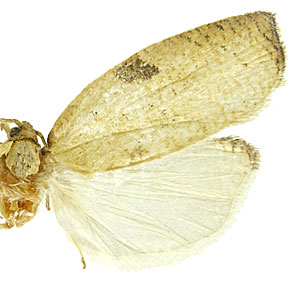Overview

The genus Amorbia contains approximately 40 species. Most are distributed in the Neotropics, although a few are present in the Nearctic. Adults are characterized by the absence of ocelli, a dark line of scales on the apical area of the hindwing, and several genitalic characters, including: gnathos absent; aedeagus lacking external armature; corpus bursae sac-shaped; signum large and band-shaped; and sterigma developed into a pair of lateral pockets (Phillips-Rodriguez and Powell 2007).
The majority of Amorbia larvae arriving at U.S. ports are from Central and South America. Larvae have been intercepted on Crataegus (hawthorn), Limonium (lavender), Ocimum (basil), Persea (avocado), Rubus (blackberry, raspberry, etc.), and cut flowers. Interceptions are very common although most specimens are not identified to species.
Late instar larvae can be distinguished by the dark brown to black lateral bands on the head and prothoracic shield. Identification of early instars is difficult as the lateral bands are often absent and molecular diagnostics may be necessary to confirm identity.
For more information on Amorbia larvae, please consult the fact sheet and keys on LepIntercept - An identification resource for intercepted Lepidoptera larvae.
The two species treated here, A. cuneana and A. emigratella, are occasional pests of various crops in western North America. Adults and larvae are most often encountered as non-target captures during surveys for exotic pests such as Epiphyas postvittana. For photos of additional non-targets not covered here, visit the Moth Photographers Group link below.
Non-target species Amorbia cuneana
Amorbia emigratella
Links

The following external links require an internet connection. The authors, CSU, CDFA, and USDA/APHIS/PPQ/CPHST are not responsible for the availability or content of these external sites:
Moth Photographers Group - Sparganothini
References

Faber, B. A., J. G. Morse and M. S. Hoddle. 2010. UC IPM Pest Management Guidelines - Avocado. University of California IPM Online. http://www.ipm.ucdavis.edu/PMG/selectnewpest.avocado.html.
Fullaway, D. T. and N. L. H. Krauss. 1945. 193. Amorbia emigratella Busck, pp. 122-123. In Common Insects of Hawaii. Tongg Publishing Company, Honolulu. 228 pp.
Phillips-Rodriguez, E. and J. A. Powell. 2007. Phylogenetic relationships, systematics, and biology of the species of Amorbia Clemens (Lepidoptera: Tortricidae: Sparganothini). Zootaxa. 1670. 109 pp.
Powell, J. A. and P. A. Opler. 2009. Moths of western North America. University of California Press, Berkeley. 369 pp.
Zimmerman, E. C. 1978. Insects of Hawaii, Volume 9, Microlepidoptera, Part 1. University of Hawaii Press, Honolulu, Hawaii. 881 pp.
Photo Credits

Fig. 9: University of California Statewide IPM Program (UC IPM Web Site)

